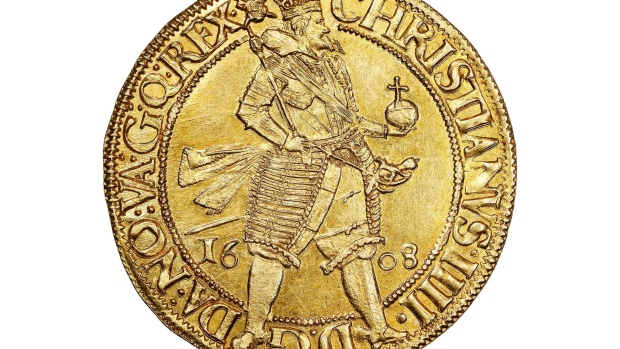Apr 23, 2024
Danish heirs to sell US$72 million rare coin collection after 100 years
, Bloomberg News

The descendants of the Danish butter magnate Lars Emil Bruun waited exactly 100 years to claim their now US$72 million inheritance. Not by choice.
At least one grandchild reportedly tried and failed to break Bruun’s will, which specified that his 20,000-piece coin collection should remain intact and stored away, then be sold at auction after a century elapsed.
Now, finally, the time has come. The trove of coins and medals will be sold over several years via the coin auction house and dealer Stack’s Bowers. The first tranche of the collection is set to hit the block this fall. “When I first heard about the collection a couple years back,” says Vicken Yegparian, the company’s vice president for numismatics, “I was flabbergasted that something like this could exist.”
Safekeeping cultural patrimony
Over the course of his life, Bruun (1852-1923) created a monumental collection of coins, medals and paper currency, predominantly from countries with some connection to Scandinavia.
“You’ve got Denmark, Norway, Sweden and then places that used to be under Danish or Norwegian or Swedish rule,” says Yegparian, name-checking places as varied as the Danish West Indies (now the U.S. Virgin Islands) and Tranquebar (now Tharangambadi), a onetime Danish outpost in India. Bruun even collected English coins from when the Danes ruled the country. “There’s a huge run of coins from King Canute of England,” Yegparian says.
Once Bruun had accumulated all these objects, though, he began to weigh their national significance.
Having lived through the devastation of World War I, Bruun was understandably skittish about Denmark’s cultural patrimony. As a consequence, he decided to frame his collection as a sort of backup to the Royal Danish Collection of Coins and Medals, “as a redundancy and a protection against something happening to the existing collection,” says Brian Kendrella, president of Stack’s Bowers. Bruun decided that after 100 years, if the national collection had remained intact, it would be safe to sell his own collection at public auction. Proceeds were willed to his direct heirs.
And so for the past 100 years his collection has sat, mostly undisturbed, available to scholars when they’ve asked and locked away to everyone else, Kendrella says.
Living with a gold mine
Through the auction house, his heirs declined to comment. The Danish media have been interested in this story for years, however, and from time to time, Bruun’s descendants have commented publicly on the looming inheritance, with one noting that his father was a taxi driver and that he might “buy a new golf set” if and when the collection was sold.
The irony, Yegparian says, is that by stashing away his collection for 100 years, Bruun managed to successfully safeguard his family’s intergenerational wealth. “I read somewhere that in the late teens or early 1920s, Bruun was worth the equivalent of $200 million in today’s dollars,” he says. “In that time period, the collection has taken an outsized value to what it might’ve been in 1923.”
As such, today’s beneficiaries “aren’t wealthy as a result of inheritance or anything like that,” says Kendrella, who negotiated with a small group of the heirs (the total number hasn’t been publicly disclosed) to win the consignment of the collection. “I have not specifically talked with them about what it’s been like to have this in the family for the past hundred years and how that’s impacted them.” But, he continues, after earlier unsuccessful attempts to break the will, the heirs have been “kind of just patient—‘It will be what it will be’—and they’ve really been delightful to work with.”
Selling it all
Stack’s Bowers is still cataloging the collection, which was last inventoried after Bruun’s death and includes single line items such as “43 medals,” Kendrella says. But, he says, they can safely say the collection consists of roughly 20,000 objects. There’s about 15,000 coins, 4,600 medals and tokens, 330 bank notes, and then about 1,800 book titles, many of which are multivolume.
The valuation, Kendrella says, is based on the 500 million Danish kroner (US$72 million) that the collection is insured for. Although insurance values can often be inflated, “in this case, everything that we’ve done so far supports that amount as a pretty reasonable valuation,” he says.
Given the collection’s volume, in conjunction with its targeted subject matter, the auction house is still working out how to formulate its sales and to whom they should market the pieces. Multiple records have been set in the coin collecting market recently: In 2021, Sotheby’s broke records, selling a gold coin for $18.9 million; earlier this month, Stack’s Bowers sold a Comitia Americana medal for $900,000, setting a world record for a bronze medal ever sold at auction, according to the auction house.
In the coin market, says Kendrella, “we didn't see the kind of crazy increases that you saw in things like sports cards and maybe some of the other areas” during and post-Covid-19. “I think we saw a much more sustained, steady and healthy growth.” As a result, he continues, “prices that we’re seeing haven’t experienced the drop-off over the past 12 or 18 months you’ve seen in other categories.”
There are several obvious markets for the Bruun collection, Yegparian says. “I think the no-brainer is domestic Scandinavian demand,” he says. “But I think there’s these bigger rarities that are going to be contested internationally.” Like most collectibles markets, he says, the coin market is bifurcated, with the top of the market experiencing intense demand, with everything else lagging behind.
“There’s going to be demand from American collectors and European collectors and Asian collectors who might not have collected Scandinavian coinage in a meaningful way,” Yegparian says, “but are going to be mesmerized by the story and the rarity and the value of these things and pursue them accordingly.”
